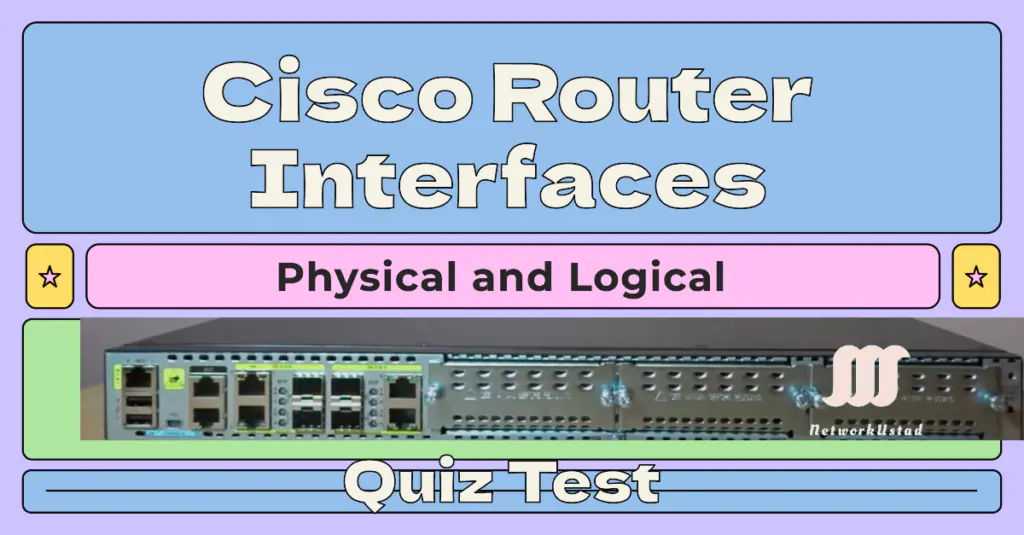Cisco Router Interfaces: The Ultimate 2025 Guide for CCNA Students
Routers are the backbone of modern networks, and understanding their interfaces is the first step toward mastering network configuration. Whether preparing for the CCNA exam or managing enterprise infrastructure, this 2025 guide covers everything from legacy Ethernet ports to cutting-edge SD-WAN interfaces.
In 2025, router interfaces are evolving with AI-driven traffic management and 5G backhaul, making this guide essential for CCNA aspirants and enterprise engineers.
Physical Interface
Physical interface connects routers to networks via cables or wireless links, evolving from classic Ethernet to 2025’s 400G and 5G interfaces.
Classic Physical Interface
Ethernet (FastEthernet/GigabitEthernet)
Ethernet is typically the router’s physical interface based on the IEEE 802.3 standard. The port’s operating speed is 10 Mbps, and the media standard for this interface is 10BaseT.
Fast Ethernet, or the FE interface, is an IEEE 802.3u standard-based physical interface. Its operating speed is 100 Mbps, and its media standard is 100BaseT.
Gigabit Ethernet is also known as the GE interface. This port’s standard is Ethernet IEEE 802.3ab. Gigabit Ethernet can connect at the remarkable speed of 1000mb/s. The media standard used is 1000BASE-T.
As of 2025, Gigabit Ethernet upgrades to 10G/400G variants are standard in data centers, supporting AI workloads and high-density IoT networks.
Configuration:
Router(config)# interface GigabitEthernet0/0 Router(config-if)# ip address 192.168.1.1 255.255.255.0 Router(config-if)# no shutdown
Pro Tip: Use show interfaces GigabitEthernet0/0 to verify status.
Serial interface
Serial interface transmits data via voltage pulses for WAN connections (e.g., T1, Frame Relay), though their use declines in 2025 with SD-WAN adoption.
Use Case: Legacy WAN connections (Frame Relay, HDLC).
Example:
Router(config)# interface Serial0/1/0 Router(config-if)# encapsulation hdlc
Modern Physical Interface
In 2025, 5G cellular interface on Cisco ISR routers enables low-latency backups for SD-WAN, while IoT interfaces support Zigbee 3.0 for smart grids.
Cellular Interfaces (4G/5G)
Use Case: Backup connectivity for remote sites.
CLI Configuration:
Router(config)# interface Cellular0/1/0 Router(config-if)# ip address dhcp Router(config-if)# dialer lte enable
IoT Interfaces (Bluetooth/Zigbee)
Use Case: Smart sensors in industrial networks (Cisco IR1100).
Configuration:
Router(config)# interface BLE0 Router(config-if)# zigbee coordinator
Logical Interfaces
Logical interfaces are software-defined and critical for advanced routing.
Loopback interface
A loopback interface is a logical, virtual interface in a Cisco Router. This is not a physical interface like a Fast Ethernet or Gigabit Ethernet interface. A loopback interface has essential uses, such as an OSPF Router ID.
Use Case: Stable Router IDs for OSPF/BG
Setup:
Router(config)# interface Loopback0 Router(config-if)# ip address 10.0.0.1 255.255.255.255
Subinterfaces
Use Case: VLAN tagging (Router-on-a-Stick).
Example:
Router(config)# interface GigabitEthernet0/0.10 Router(config-subif)# encapsulation dot1Q 10 Router(config-subif)# ip address 192.168.10.1 255.255.255.0
Tunnel Interfaces
Use Case: VPNs (GRE/IPsec).
GRE Tunnel Setup:
Router(config)# interface Tunnel1 Router(config-if)# tunnel source GigabitEthernet0/0 Router(config-if)# tunnel destination 203.0.113.5 Router(config-if)# ip address 10.10.10.1 255.255.255.252
Null Interface
A null interface is a virtual interface that discards IP packets to prevent routing loops in the network. We do not assign the IP address to a null interface.
Modern Interfaces
SD-WAN Interfaces
Use Case: Cloud-connected branch offices.
CLI Configuration:
Router(config)# interface SD-WAN-Tunnel1 Router(config-if)# service-policy BRANCH-QOS Router(config-if)# vpn 10
VASI (Virtual and Automation Services Interface)
Use Case: SD-Access and network automation.
Example:
Router(config)# interface VASI1 Router(config-if)# service-context automation
Troubleshooting Common Issues
Interface Status “Down/Down”
Check Cable Connections:
Router# show interfaces status
The show interfaces status Command on a Cisco device concisely summarizes interface status, including administrative state, physical connectivity, VLAN assignments, and speed/duplex settings. When an interface is administratively shut down (using the shutdown command), the output will reflect this state explicitly:
Router# show interfaces FastEthernet0/1
FastEthernet0/1 is administratively down, line protocol is down
Hardware is Lance, address is 000b.be66.0b01 (bia 000b.be66.0b01)
MTU 1500 bytes, BW 100000 Kbit, DLY 1000 usec,
reliability 255/255, txload 1/255, rxload 1/255
Encapsulation ARPA, loopback not set
Keepalive set (10 sec)
Auto-duplex, Auto-speed
ARP type: ARPA, ARP Timeout 04:00:00
Last input never, output never, output hang never
Last clearing of "show interface" counters never
Input queue: 0/75/0/0 (size/max/drops/flushes); Total output drops: 0
Queueing strategy: fifo
Output queue :0/40 (size/max)
5 minute input rate 0 bits/sec, 0 packets/sec
5 minute output rate 0 bits/sec, 0 packets/sec
0 packets input, 0 bytes, 0 no buffer
Received 0 broadcasts, 0 runts, 0 giants, 0 throttles
0 input errors, 0 CRC, 0 frame, 0 overrun, 0 ignored, 0 abort
0 watchdog, 0 multicast, 0 pause input
0 input packets with dribble condition detected
0 packets output, 0 bytes, 0 underruns
0 output errors, 0 collisions, 0 interface resets
0 babbles, 0 late collision, 0 deferred
0 lost carrier, 0 no carrier
0 output buffer failures, 0 output buffers swapped out
Enable the Interface:
Router(config-if)# no shutdown
Router(config-if)#
*Mar 1 00:06:05.515: %LINK-3-UPDOWN: Interface FastEthernet0/1, changed state to up
*Mar 1 00:06:06.515: %LINEPROTO-5-UPDOWN: Line protocol on Interface FastEthernet0/1, changed state to up
Duplex Mismatch
Router(config)# interface GigabitEthernet0/0
Router(config-if)# duplex full
Router(config-if)# speed 1000
In 2025, Cisco’s Embedded Event Manager (EEM) automates interface troubleshooting, reducing downtime in 400Gbps environments.
CCNA Lab Exercises
Lab 1: Configure a GRE Tunnel
- Step 1: Create Tunnel Interface
- Step 2: Verify with
ping 10.10.10.2.
Lab 2: VLAN Subinterface Setup
- Step 1: Create Subinterface
- Step 2: Test inter-VLAN routing.
2025 Interface Optimization Techniques
In 2025, optimize router interfaces with QoS for 5G traffic, mGig for Wi-Fi 7, and AI analytics for predictive maintenance on Cisco 8000 Series routers.
Conclusion
This guide equips you with skills to configure and troubleshoot router interfaces, from Ethernet to SD-WAN, preparing you for CCNA exams and enterprise roles.
Need Help? Share your setup in the comments, and our team will troubleshoot!
